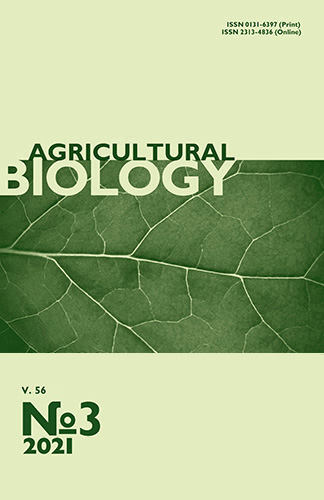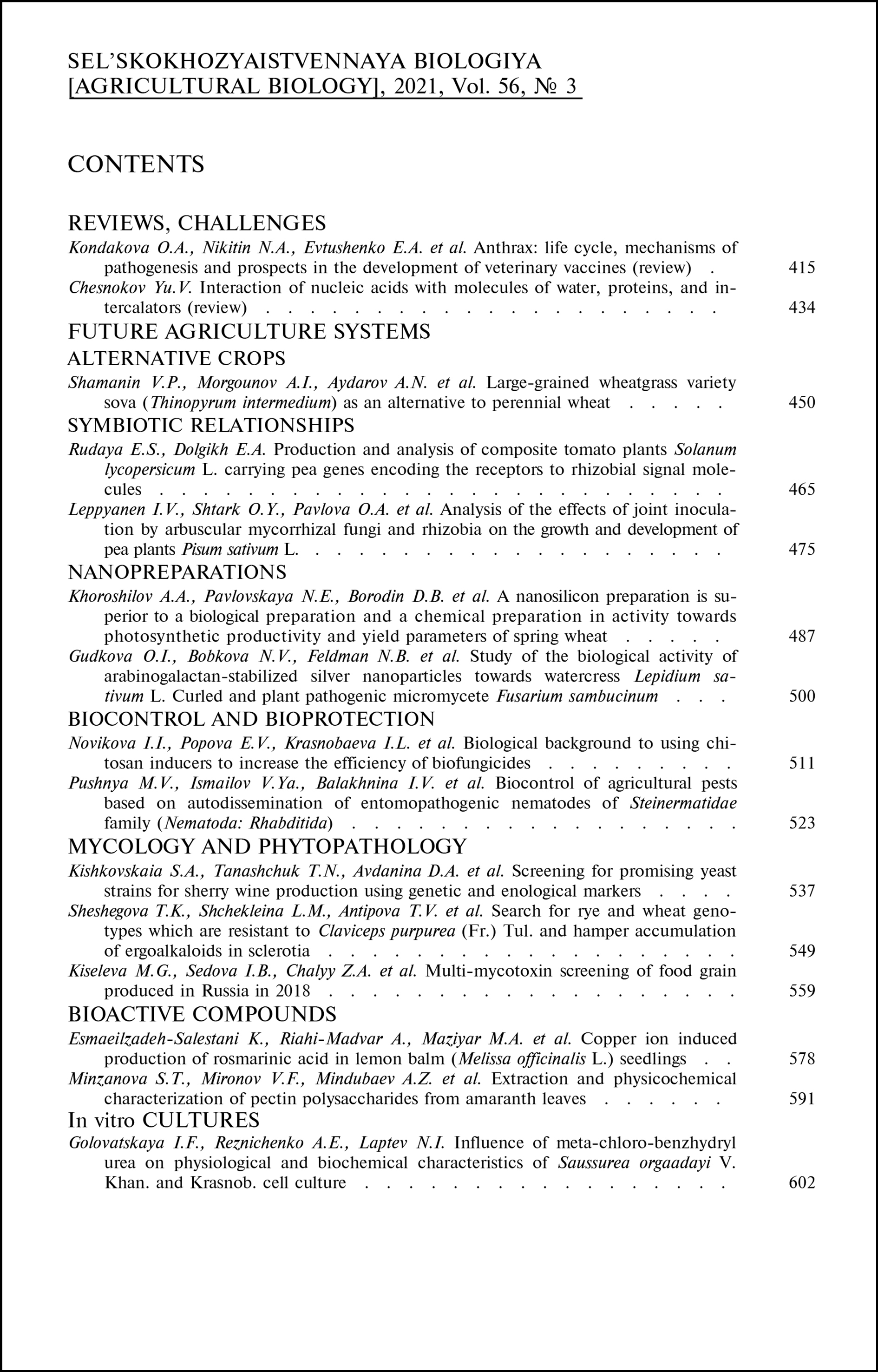doi: 10.15389/agrobiology.2021.3.549eng
UDC: 633.1:631.524.86:632.4
Acknowledgements:
The authors are grateful to B.P. Baskunov (Skryabin Institute of Biochemistry and Physiology of Microorganisms RAS) for the mass spectrometric data.
SEARCH FOR RYE AND WHEAT GENOTYPES WHICH ARE RESISTANT TO Claviceps purpurea (Fr.) Tul. AND HAM-PER ACCUMULATION OF ERGOALKALOIDS IN SCLEROTIA
T.K. Sheshegova1 ✉, L.M. Shchekleina1, T.V. Antipova2,
V.P. Zhelifonova2, A.G. Kozlovskiy2
1Rudnitsky Federal Agricultural Research Center of the North-East, 166a, ul. Lenina, Kirov, 610007 Russia, e-mailimmunitet@fanc-sv.ru (corresponding author ✉), sheshegova.tatyana@yandex.ru;
2Skryabin Institute of Biochemistry and Physiology of Microorganisms RAS — a separate subdivision of the Federal Research Center Pushchino Scientific Center for Biological Research RAS, 5, Prospekt Nauki, Pushchino 142290 Russia, e-mail kozlovski@ibpm.pushchino.ru, tatantip@rambler.ru, zhelifonova@yandex.ru
ORCID:
Sheshegova T.K. orcid.org/0000-0003-2371-4949
Zhelifonova V.P. orcid.org/0000-0001-9213-9584
Shchekleina L.M. orcid.org/0000-0002-3589-5524
Kozlovskiy A.G. orcid.org/0000-0002-7140-1210
Antipova T.V. orcid.org/0000-0002-4860-2647
Received April 1, 2021
Ergot [Claviceps purpurea (Fr.) Tul.] is a progressive disease of rye and wheat crops. Ergot alkaloids (EA) derived from the fungus can cause severe health problems in both humans and animals. Ergot-resistant cereals are the guarantors to solve the problem. Here, we aimed to determine the EA profiles and content in sclerotia of the Kirov population of C. purpureа and to search for rye and wheat genotypes resistant to ergot and with no EA accumulation to be used as sources of these traits in breeding. One hundred varieties of winter rye (Secale cereale L.) and spring soft wheat (Triticum aestivum L.) obtained from the collection of the Vavilov All-Russian Institute of Plant Genetic Resources (VIR) and bred at the Rudnitsky Federal Agricultural Research Center of the North-East were tested in 2017-2019 for ergot resistance by artificial inoculation of flowers with a suspension of C. purpureа conidia (3×106/ml). EA profiles and amount were estimated by thin layer chromatography on silica gel plates (Silica gel F254, Merck, Germany). The metabolites were identified by co-chromatography with standards and by UV spectra (a UV-160A spectrophotometer, Shimadzu, Japan) and mass spectra (an LCQ Advantage MAX spectrometer, Thermo Finnigan, Germany). Most of the tested samples were susceptible to ergot. In wheat, only two varieties were immune (Novosibirskaya 18 and a new line T-66) and 13 varieties were relatively resistant with a lesion level of no more than 5.2 % and a sclerotia content in grain of no more than 0.3 % vs. 21.7 % and 1.5 % in the most susceptible (indicator) variety. In winter rye, immune forms were absent, in 10 varieties, the lesion varied from 5.8 % to 33.0 % and sclerotia contamination of grain from 0.3 % to 1.4 % vs. 100 % and 37.0 % in the indicator) variety). The immune and least affected varieties of rye and wheat can be used in breeding programs as genetic sources for the trait. The EA composition and amount in the fungus C. purpurea sclerotia were analyzed in 30 varieties of rye and wheat with different susceptibility to ergot. The EA composition was the same and consisted of ergocristine, ergotamine, and its stereoisomer ergotaminine. Only in the Kazakh wheat variety Samgau, we identified one EA, the ergotamine. The amount of EA in sclerotia varied from 0 % to 0.36 % of their weight for rye plants and from 0 to 2.40 % for wheat plants. Nine new rye populations bred at the at the Rudnitsky Federal Agricultural Research Center of the North-East and four wheat varieties do not accumulate EA. A weak negative relationship was found between the weight of a sclerotium and the EA accumulation, r = -0.46 (p = 0.05) for winter rye and r = -0.32 (p = 0.05) for spring wheat. The revealed tendency increases the biological hazard of the small and most difficult to separate fraction of sclerotia in the grain mass. No significant relationship was found between the toxicity and pathogenicity of the fungus C. purpurea as evidenced by the correlation between the ergot occurrence and the EA content in the rye (r = 0.22, p = 0.05). Nevertheless, data on the EA level are important for the search for immunologically and breeding-valuable genotypes that combine resistance to ergot and no EA accumulation. This trait is characteristic of the German wheat variety Epos and the new rye populations Rumba, Harmony, and Symphony.
Keywords: winter rye, spring wheat, ergot, Claviceps purpurea, sclerotia, resistant cultivars, ergo alkaloids, toxicity, pathogenicity.
REFERENCES
- Ponomareva M.L., Ponomarev S.N., Mannapova, G.S., Ilalova, L.V. Vestnik Krasnoyarskogo gosudarstvennogo agrarnogo universiteta, 2019, 9(150): 27-34 (in Russ.).
- Shchekleina L.M. Agrarnaya nauka Evro-Severo-Vostoka, 2019, 20(2): 134-143 CrossRef (in Russ.).
- Urban E., Gordei S. Nauka i innovatsii, 2018, 5(83): 77-80 (in Russ.).
- Nemkovich A.I. Zashchita i karantin rastenii, 2006, 6: 25-26 (in Russ.).
- Kadyrov A.M. Zemledelie i selektsiya v Belorussii, 2003, 39: 225-229 (in Russ.).
- Miedaner T., Geiger H.H. Biology, genetics and manogement of ergot (Claviceps spp.) in rye, sorghum and pearl mille. Toxins, 2015, 7(3): 659-678 CrossRef
- Khochenkov A.A., Khodosovskii D.N., Solyanik V.V., Bezmen V.A. Izvestiya Akademii agrarnykh nauk Respubliki Belarus', 2000, 3: 74-77 (in Russ.).
- Shchekleina L.M., Sheshegova T.K. Vestnik Krasnoyarskogo GAU, 2020, 6: 86-92 CrossRef (in Russ.).
- Sheshegova T.K., Shchekleina L.M., Zhelifonova V.P., Antipova T.V., Baskunov B.P., Kozlovskii A.G. Mikologiya i fitopatologiya, 2019, 53(3): 177-182 CrossRef (in Russ.).
- Goncharenko A.A. Materialy Vserossiiskoi nauchno-prakticheskoi konferentsii «Ozimaya rozh': selektsiya, semenovodstvo, tekhnologii i pererabotka» [Proc. All-Russian Conf. «Winter rye: breeding, seed production, technologies and processing»]. Ufa, 2009: 40-76 (in Russ.).
- Gagkaeva T.Yu., Dmitriev A.P., Pavlyushin V.A. Zashchita i karantin rastenii, 2012, 9: 14-18 (in Russ.).
- Pažoutova S., Pešicova K., Chudčkova M., Srůtka P., Kolařik M. Delimitation of cryptic species inside Claviceps purpurea. Fungal Biology, 2015, 119(1): 7-26 CrossRef
- Roberts A., Beaumont C., Manzarpour A., Mantle P. Purpurolic acid: A new natural alkaloid from Claviceps purpurea (Fr.) Tul. Fungal Biology, 2016, 120(1): 104-110 CrossRef
- Schardl C.L. Introduction to the toxins special issue on ergot alkaloids. Toxins,2015, 7(10): 4232-4237 CrossRef
- Scott P.M. Analysis of ergot alkaloids — a review. Mycotoxin Research, 2007, 23(3): 113-121.
- Maruo V.M., Bracarense A.P., Métayer J.-P., Vilarino M., Oswald I.P., Pinton P. Ergot alkaloids at doses close to EU regulatory limits induce alterations of the liver and intestine. oxins, 2018, 10(5): 183 CrossRef
- Mantle P.G. Comparative ergot alkaloid elaboration by selected plectenchymatic mycelia of Claviceps purpurea through sequential cycles of axenic culture and plant parasitism. Biology, 2020, 9(3): 41 CrossRef
- Oeser B., Kind S., Schurack S., Schmutzer T., Tudzynski P., Hinsch J. Cross-talk of the biotrophic pathogen Claviceps purpurea and its host Secale cereale. BMC Genomics, 2017, 18(1): 273 CrossRef
- Pažoutová S., Olšovská J., Linka M., Kolínská R., Flieger M. hemoraces and habitat specialization of Claviceps purpurea populations. Applied and Environmental Microbiology, 2000, 66(12): 5419-5425 CrossRef
- Zvonkova E.N., Shain S.S., Saibel' E.S. Rossiiskii khimicheskii zhurnal, 2005, 49(1): 125-134 (in Russ.).
- Miedaner, T., Dänicke S., Schmiedchen B., Wilde P., Wortmann H., Dhillon B.S., Geiger H.H., Mirdita V. Genetic variation for ergot (Claviceps purpurea) resistance and alkaloid concentrations in cytoplasmic-male sterile winter rye under pollen isolation. Euphytica, 2010, 173(3): 299-306 CrossRef
- Mainka S., Dänicke S., Böhme H., Ueberschär K.-H., Liebert F.n the composition of ergot and the effects of feeding different ergot sources on piglets. Animal Feed Science and Technology, 2007, 139(1): 52-68 CrossRef
- Mirdita V., Miedaner T. Resistance to ergot in self‐incompatible germplasm resources of winter rye. Journal of Phytopathology, 2009, 157(6): 350-355 CrossRef
- Safonova I.V., Anis'kov N.I., Kobylyanskii V.D. Vavilovskii zhurnal genetiki i selektsii, 2019, 23(6): 780-786 CrossRef (in Russ.).
- Mirdita V., Dhillon B.S., Geiger H.H., Miedaner T. Genetic variation for resistance to ergot (Claviceps purpurea [Fr.] Tul.) among full-sib families of winter rye (Secale cereale L.). Theoretical and Applied Genetics, 2008, 118(1): 85-90 CrossRef
- Miedaner T., Mirdita V., Rodemann B., Drobeck T., Rentel D. Genetic variation of winter rye cultivars for their ergot (Claviceps purpurea) reaction tested in a field design with minimized interplot interference. Plant Breeding,2010, 129(1): 58-62 CrossRef
- Sysuev V.A., Saitov V.E., Farafonov V.G., Suvorov A.N., Saitov A.V. Theoretical background of calculating of the parameters of the device for grain cleaning from ergot sclerotia. ussian Agricultural Sciences, 2017, 43(3): 273-276 CrossRef
- Sysuev V.A., Saitov V.E., Farafonov V.G., Saitov A.V. Inzhenernye tekhnologii i sistemy, 2019, 29(2): 248-264 CrossRef (in Russ.).
- Saitov V.E., Farafonov V.G., Saitov A.V. Experimental substantiation of the effective height of a grain falling by a stream of liquid in an ergot release device. IOP Conference Series: Earth and Environmental Science, 2019, 341: 1-6 CrossRef












